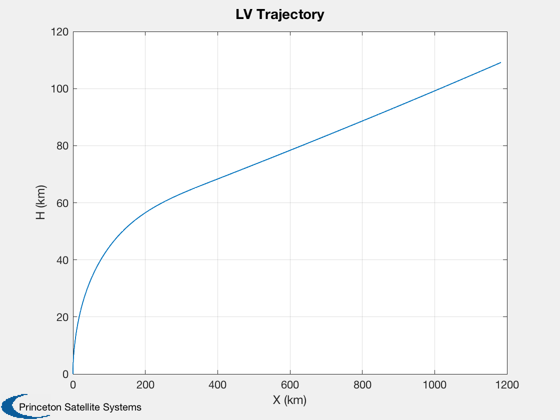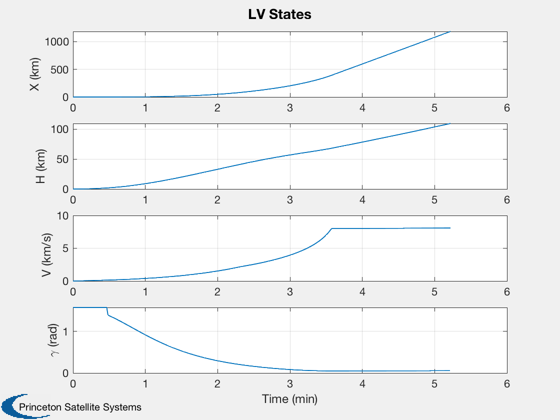Simulate a gravity turn trajectory in 2D.
The goal is to get the vehicle moving horizontally at orbital velocity.
Uses RHSLaunchVehicle2D which has a 'flat' earth. The simulation can handle any number of stages which are set by the arrays d.mSS, d.thrust, d.uE and d.cDA each of which have one element for each stage.
You vary the pitchover angle to get different trajectories. The number in the script gives the vehicle a horizontal trajectory (that begins to drop due to drag) at 53 km. The trajectory is very sensitive to gammaPitchover - on the order of a fraction of a degree.
------------------------------------------------------------------------ See also RHSLaunchVehicle2D, RK4, Plot2D, TimeLabl ------------------------------------------------------------------------
Contents
%------------------------------------------------------------------------------- % Copyright (c) 2007 Princeton Satellite Systems, Inc. % All Rights Reserved. %------------------------------------------------------------------------------- clear d; dT = 1;
Control
%-------- gammaPitchover = 10.5*pi/180; % rad kPitch = 30; % steps
Vehicle model
%--------------- % For this demo vehicle, try pitchover of 10.5 degrees at 30 seconds lv = struct; lv.mSS = [ 5000 600 400]; % Dry mass of each stage lv.mSP = [30000 8000 20]; % Fuel mass of each stage lv.thrust = [600 300 0.5]; % Thrust of each stage (kN) lv.uE = [285 285 252]*9.806*1e-3; % Exhaust velocity of each stage (m/s) lv.mPLD = 100; lv.mDot = lv.thrust ./ lv.uE; lv.tBurn = lv.mSP./lv.mDot; % RHS data d = LaunchRHSData( 2, lv ); d.cDA = 0.35*[2 1 1]; % Drag coefficient of each stage times area
Initialization
nSim = floor(sum(lv.tBurn)/dT); %----------------------------------------- % [x h v gamma massFuel] % x Downrange distance % h Altitude % v Velocity % gamma Flight path angle %----------------------------------------- x = [0; 0; 0; pi/2; lv.mSP']; disp('Initial acceleration should be positive:') xDot = RHSLaunchVehicle2D( x, 0, d ); disp(xDot(3)) % Store plot points in x %----------------------- x = [x zeros(length(x),nSim)];
Initial acceleration should be positive:
0.0038011
Simulation
%------------ for k = 1:nSim % Initiate pitchover %------------------- if( k == kPitch ) x(4,k) = pi/2 - gammaPitchover; fprintf(1,'\tPitch-over altitude: %f\n',x(2,k)); fprintf(1,'\tPitch-over velocity: %f\n',x(3,k)); end % Propagate one step %------------------- x(:,k+1) = RK4( @RHSLaunchVehicle2D, x(:,k), dT, k*dT, d ); if( x(2,k+1) <= 0 ) disp('Negative altitude (hit the earth), terminating.') break; end end nSim = k; x = x(:,1:(nSim+1));
Pitch-over altitude: 1.877182 Pitch-over velocity: 0.139398
Plotting
% Create the time array and label %-------------------------------- [t, tL] = TimeLabl( (0:nSim)*dT ); % Plot the trajectory %-------------------- Plot2D( x(1,:), x(2,:), 'X (km)', 'H (km)', 'LV Trajectory'); % Plot the states %---------------- yL = {'X (km)' 'H (km)' 'V (km/s)' '\gamma (rad)'}; Plot2D( t, x(1:4,:), tL, yL, 'LV States'); % Compute the mass %----------------- m = zeros(1,nSim+1); for k = 1:(nSim+1) mF = x(5:end,k); j = find(mF > 0,1,'first'); m(k) = sum(mF) + sum(lv.mSS(j:end)) + lv.mPLD; end yL = {'LV Mass (kg)'}; for k = 1:length(mF) yL = {yL{:} sprintf('Fuel %i (kg)',k)}; end % Plot the mass %-------------- Plot2D( t, [m;x(5:end,:)], tL, yL, 'LV Mass'); %-------------------------------------- % PSS internal file version information %--------------------------------------


